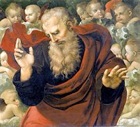Four chapels were built in the late 14th century, one at each of the external angles of the crossing, probably (in some cases) in an attempt to stabilise the structure:
-
✴Baldo degli Ubaldi and his brothers built the Cappella Baldeschi in the 14th century, between the campanile (to the left of the apse) and the right wall of the left transept.
-
✴Giovanni Montesperelli built Cappella Montesperelli, a semi-circular chapel off the left wall of the right transept, in the 15th century.
-
✴The Michelotti family built the Cappella di San Matteo between the left wall of the right transept and the right wall of the nave in the 14th century. Biordo Michelotti was probably buried here after his murder in 1398. It passed to the Baglioni family in the following year, at which point it became known as the Cappella Baglioni.
-
✴The arms on the double chapel between the right wall of the left transept and the left wall of the nave belong to the Carbonchi and Podiani families. Guido degli Oddi acquired it in 1461, at which point it became known as the Cappella degli Oddi.
Two other structures are included in this page:
-
✴the Oratorio dei SS Girolamo, Francesco e Bernardino (1450), which was established in the convent; and
-
✴the Cappella del Gonfalone (1464), which was built against the facade of San Francesco al Prato to house the Gonfalon di San Francesco al Prato.
Cappella Baldeschi
This chapel, which was first documented in 1390, was dedicated to St Louis of Toulouse. It belonged to the jurist Baldo degli Ubaldi and his brothers. It was included in the restoration project of 1740-8, and still survives. The remains of the jurist Bartolo da Sassoferrato (died 1357) were moved here after a restoration of the chapel in 1971.
Art from the Chapel
Altar (1475)
Giugliotto and Antonio Baldeschi commissioned what (judging by its cost) must have been an elaborate altar from Agostino di Duccio, but this no longer survives.
Last Judgement (16th century)
This altarpiece, which is attributed to Dono Doni was recorded in the chapel in 1683. It was moved to the choir during the restoration of 1740-8. It was removed in 1863 and is now in the Galleria Nazionale.
Cappella Montesperelli
This chapel, which was built in the 15th century, was dedicated to St Antony of Padua.
Art from the Chapel
Panels from a polyptych (ca. 1455)
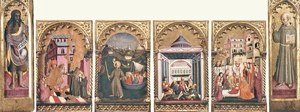
A document dated 1455 records a payment by Giovanni Montesperelli to Mariano di Antonio for a Maestà (now lost) that he had commissioned for his chapel in San Francesco al Prato. It is possible that this work was part of a polyptych that also included six panels attributed to Mariano di Antonio that were first recorded in 1810, when they were transferred from San Francesco al Prato to the Accademia di Belle Arti:
-
✴Four of the panels, which depict miracles of St Antony of Padua (to whom this chapel was dedicated), probably came from the predella; and
-
✴the other two, which depict SS John the Baptist and Bernardino of Siena, probably came from the pilasters. The fact that St Bernardino, who was canonised in 1450, is depicted with a halo is consistent with this dating.
If these assumptions are correct, this is the only securely documented work by Mariano di Antonio.
The six panels are now in the Galleria Nazionale.
Cappella Baglioni
This chapel, which was built at the external angle between the right transept and the right wall of the nave originally belonged to the Michelotti family, and Biordo Michelotti was probably buried in it after his murder in 1398.
The chapel was ceded to Atlanta Baglioni and her son, Grifonetto Baglioni, in 1499. The document recording this mentioned that Atlanta had taken over the patronage from her mother, Angela di Acquaviva, who had died in 1494. Grifonetto was buried here after his murder in 1500, and Atlanta was buried here in 1509.
Art from the Chapel
Baglioni Altarpiece (1507)
A lost inscription apparently recorded that Atalanta Baglioni commissioned this altarpiece, which is signed by Raphael and dated by inscription. Giorgio Vasari reported that Raphael made the cartoon in Florence and then returned to Perugia to paint the altarpiece in Atalanta's chapel here. The commission was probably made in ca. 1505, and Raphael seems to have returned to Perugia from Florence in 1507 in order to deliver it. Domenico Alfani was associated in some way with the commission: a note that Raphael addressed to him on the back of a sketch (ca. 1507) of the Holy Family that is now in the Palais des Beaux Arts, Lille asks him (among other things) to obtain payment on his behalf from Atalanta Baglioni
Main panel
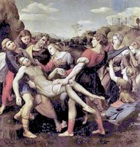
-
✴the body of Christ, which is laid on a sheet, is carried by two men, one of which (at the centre of the composition) almost certainly represented Atalanta's son, Grifonetto;
-
✴St John the Evangelist and a fourth man stand near the head of Christ;
-
✴St Mary Magdalene holds His hand; and
-
✴the Virgin, attended by three women, swoons at His feet.
The place of execution is on the hill to the right, and the tomb is in the rocks to the left. The panel is signed and dated on the stepping-stone to the bottom left-hand corner.
The Franciscans somewhat controversially sold this panel to Cardinal Scipione Borghese in 1608, having moved it first to the sacristy because the Cappella di San Matteo was subsiding. The French took it from Rome to Paris in 1797, but it was subsequently returned to the Galleria Borghese, Rome.
Upper Panel
-
✴Some scholars believe it to be the original, and suggest that it is a workshop production (sometimes attributed to Domenico Alfani) from a design by Raphael. (A possible design, which is attributed to Raphael, survives in the Palais des Beaux Arts, Lille).
-
✴Other scholars (and the gallery notes) suggest that this panel is a copy (ca. 1608) of the original and attribute it to Stefano Amadei. If it is indeed a copy, the original has been lost.
The panel depicts the figure of God the Father, who would have looked down across the intervening frame into the face of His dead Son.
Predella
The grisaille predella panels, which depict personifications of Hope, Charity and Faith in tondi, with putti between them, remained in the sacristy in 1608. The frame of the altarpiece was recorded in 1784 in the crossing of San Francesco al Prato, at which time it contained copies of the main and upper panels, with the original predella panels below. Napoleon's commissioner, Jacques-Pierre Tinet selected the predella panels for confiscation in 1797. Antonio Canova recovered them in 1815, when they were secured for the Pinacoteca Vaticana. They are illustrated in the Vatican website.
Copy (1609) of Raphael’s Baglioni Deposition
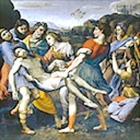
The copy was recorded:
-
✴near the Cappella dei Baldeschi, San Francesco al Prato in 1671:
-
✴above the high altar of the Oratorio di San Bernardino (in the original frame or perhaps a replica of it, with the upper panel of God the Father described below and copies of the original predella panels) in 1683;
-
✴above a door in the chapel in San Francesco al Prato that had originally housed the original in 1784 and 1787.
Although it was listed among works to be sent to the Musei Capitolini, Rome in 1812, it was subsequently decided that it should remain in the church. It entered the Galleria Nazionale in 1863.
God the Father (copy, ca. 1608 ??)
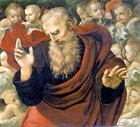
It was documented in various locations after the dismemberment:
-
✴Giovanni Francesco Morelli saw it above the high altar of the Oratorio di San Bernardino in 1683. It was in a reconstruction of the original altarpiece that also included the copy (1609) of the main panel (see above) that is attributed to Giuseppe Cesari, il Cavalier d’ Arpino . Morelli described the upper panel as a copy by Stefano Amadei.
-
✴Giuseppe Maria Modestini saw it above another altarpiece on the Altare del Presepio of San Francesco al Prato in 1787. He believed that it came from the original altarpiece by Raphael.
There is still no consensus on the status of the panel in the gallery. If it is indeed a copy, the location of the original is unknown. The gallery notes describe it as a copy attributed to Stefano Amadei.
Cappella degli Oddi (14th century)
The double chapel at the external angle between the left transept and the left wall of the nave acquired this name in 1461, when Guido degli Oddi acquired it.
Art from the Chapel
Oddi Altarpiece (ca. 1503)
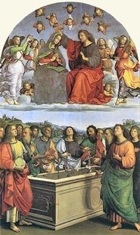
The altarpiece is generally accepted to have been painted early in Raphael's career: its commission might have coincided with the short period in 1503 during which the Oddi exiles were allowed back into Perugia under the protection of Cesare Borgia, although it is possible that the female members of the family remained in Perugia during the exile of their men. Whatever the merits of these arguments, scholars generally accept the date ca. 1503 on stylistic grounds.
The Oddi Altarpiece was one of three works in Perugia that Napoleon's commissioner, Jacques-Pierre Tinet selected for confiscation under the Treaty of Tolentino (1797). Antonio Canova recovered it in 1815, when it was secured for the Pinacoteca Vaticana.
The main panel links two scenes from the narrative of the death of the Virgin:
-
✴In the lower part of the composition, the Apostles surround the empty tomb. St Thomas stands behind it, flanked by SS Peter and Paul and holding the Virgin's girdle.
-
✴Above, Jesus crowns the Virgin on a bank of cloud, surrounded by musical angels. The upper part of the composition was probably inspired by the altarpiece (1486) of the Coronation of the Virgin that Domenico Ghirlandaio had painted for the high altar of the church of the Observant Franciscans of San Girolamo, Narni.



The predella panels, which are displayed separately in the Pinacoteca Vaticana, depict:
-
✴the Annunciation;
-
✴the Adoration of the Magi; and
-
✴the Presentation at the Temple.
Trinity with the Virgin and Saints (1553)
In 1553, Lattanzio Pagani signed an undertaking with Sforza di Lionello degli Oddi, according to which he agreed to ensure that his father, Vincenzo Pagani and and Tommaso Bernabei, il Papacello would paint this altarpiece for the Cappella degli Oddi. The undertaking specified the presence of SS Francis, Antony of Padua, John the Baptist and Bernardino of Siena, although only the first three of these appeared in the delivered work. It was transferred to the Galleria Nazionale in 1863. Although its poor condition makes attribution difficult, it is generally thought to be largely the work of il Papacello.
Cappella del Gonfalone (1464)
This chapel was built against the facade of San Francesco al Prato to house the Gonfalon di San Francesco al Prato (see below). It was remodelled in the Baroque style in 1646, closed in 1909 and demolished in in 1926 to facilitate the rebuilding of the facade (see below).
Art from the Chapel
Gonfalon di San Francesco al Prato (1464)
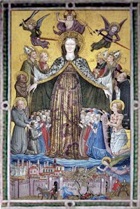
The friars of San Francesco al Prato were closely involved with these moves, following which they instituted a lay confraternity to officiate at the cult. This confraternity built the Cappella del Gonfalone against the facade, and the banner was housed in a tabernacle over its altar. In 1923, it was transferred from this chapel (prior to its demolition) to the Cappella degli Oddi (see below), which offered direct public access. It was moved to its current location in 1996.
The banner shows the Madonna della Misericordia protecting Perugia from angels firing arrows.
-
✴SS Lawrence, Herculanus, Francis, and Bernardino are on the left and
-
✴SS Louis of Toulouse, Constantius, Peter Martyr and Sebastian are on the right.
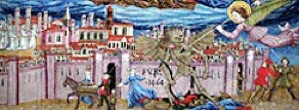
Terrified people are shown fleeing before an interesting cityscape of Perugia. The walls bear an inscription with the date of the outbreak of plague, which is presumably also the date of the commission.
Angels offering roses (ca. 1464)
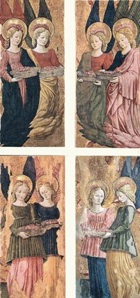
-
✴One pair came from the Oratorio dei SS Andrea e Bernardino in 1863.
-
✴The other pair came from the Cappella del Gonfalone in 1909, the year in which the chapel was closed.
Modern scholarship has determined that the panels were originally arranged in pairs, one above the other, and that they probably decorated two sides of a tabernacle. All of the angels would have looked inwards towards whatever was housed in the tabernacle: the presence of two of the panels in the Cappella del Gonfalone suggests that this was probably the Gonfalon di San Francesco al Prato (above), which is also attributed to Benedetto Bonfigli.
Mystical Marriage of St Catherine (ca. 1549)
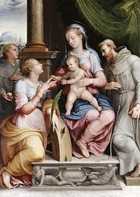
The altarpiece depicts the Madonna and Child enthroned, with St Catherine receiving a wedding ring from the baby Jesus. SS Francis and Antony of Padua stand to the sides.
Read more:
D. Cooper, “Raphael’s Altarpieces in San Francesco al Prato, Perugia: Patronage, Setting and Function”, Burlington Magazine, 143:1182 (2001) 554-61
D. Cooper, “La Commissione di Atalanta Baglioni e la Collocazione Originaria della Deposizione nella Chiesa di San Francesco al Prato”, in
K. Herrmann-Fiore (Ed), “Raffaello: La Deposizione in Galleria Borghese: Il Restauro e Studi Storico-Artistici”, 2010 (Milan) pp. 19-39
San Francesco al Prato: Main page Relics of Blessed Giles
Art from Choir Art from Exterior Chapels Other Art from Church
Return to Monuments of Perugia


